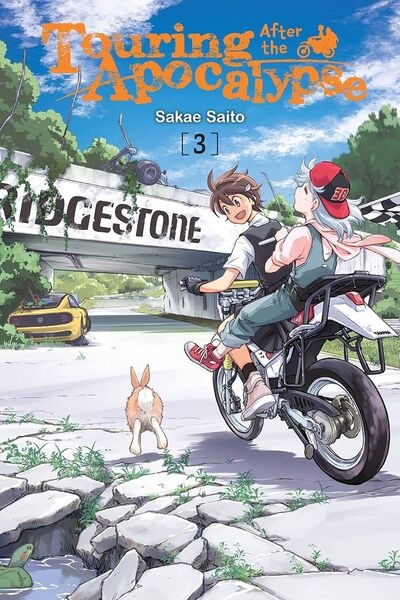Lonely Roads
Touring After the Apocalypse, volume 3
By Sakae Saito

7 May, 2025
2021’s Touring After the Apocalypse, Volume Three is the third tankōbon in Sakae Saito’s post-apocalyptic iyashikei manga. Touring has been serialized in in ASCII Media Works’ seinen manga magazine Dengeki Maoh since September 2020. Amanda Haley’s English translation was published in 2023.
Youko and Airi are living the dream… if what one dreams about is touring Japan after an unspecified disaster has (almost) entirely eradicated the human population1. Disaster tourism is a delightful experience.
Or it would be, if Airi didn’t keep falling into something like a coma.
Airi looks like a young school girl but (as the plasma cannon in her arm revealed back in Volume One) she is either a robot or a cyborg.
A message on Youko’s phone explains both what Airi is and what’s wrong with her: she is an AI (so, a robot) and she needs a software patch.
The near-total obliteration of the human and robot populations left Japan with few functioning computer repair facilities. In fact, there may be just one. Armed with directions, the pair head to the facility, which no doubt has been spared by the calamity that reduced Japan to empty ruins.

Despite this unexpected development, a fix is secured for Airi’s problem. The pair soon resume touring.
Next on the itinerary, Mobility Resort Motegi. Before the Whatever It Was, Mobility Resort Motegi was a racing Mecca (or given the nature of its staff, Mecha). There’s no reason to expect that Mobility Resort Motegi fared any better than the rest of Japan. To Youki and Airi’s surprise, the robots2 and vehicles are all functional, requiring only the flip of a power switch to reactivate the complex.
Neither Youko nor Airi understand what’s truly going on at Mobility Resort Motegi…
~oOo~
In addition to Airi sometimes falling unconscious, Youko is subject to unexplained visions of the world before the Whatever It Was. The visions don’t seem to wait for opportune moments to manifest, which I am sure is nothing to be concerned about (as the pair bike across a wreckage-strewn Japan, often at high speed).
As with previous volumes, there’s little information about the Whatever It Was. The event involved radioactivity, flooding, and the appearance of large holes where there had been none before. Authorities mounted an armed response, which may or may not have worked. If the catastrophe has stopped, did it work?
When did this happen? Enough time has passed since Whatever It Was for Japan to have become overgrown. As I don’t know how fast Japanese plants grow, I couldn’t guess how long it has been.
The artist has lovingly detailed the ruins. Also the machines, in particular the motorcycles. Less attention is paid to humans and robots, but those characters were sufficiently detailed that I never wondered who I was looking at. This is not always the case with manga or indeed comics in general.
While Airi’s software issues are alarming (although fixable), there’s nothing in this volume analogous to the tigers, storms, or legions of ravenous rats in Volume Two. This volume dabbles in eerie rather than scary. This manga isn’t as genial as Yokohama Kaidashi Kikou (at least it isn’t in Volume Two), but it’s usually interesting — or at worst melancholy — rather than terrifying.
Note that adherents of some religions may be upset by some revelations in this volume. I will say no more.
I am still resisting the urge to archive binge this, but the temptation is increasingly hard to resist….
Touring After the Apocalypse, Volume Three is available here (Yen Press), here (Barnes & Noble), here (Bookshop US), here (Bookshop UK), here (Chapters-Indigo), and here (Words Worth Books).
1: No need for USA delenda est or for any other [Nation Name Here]. The absence of visitors from outside Japan suggests the Whatever It Was was planetary scale. The universe’s supply of Beaver Tails has fallen to zero.
2: The robot names refer to a certain well-known American SF author. That said, Touring’s robots are in no way Three Laws Compliant.
